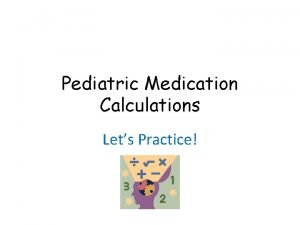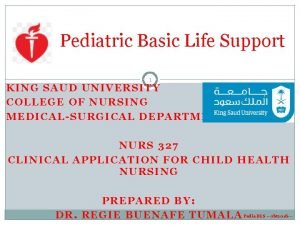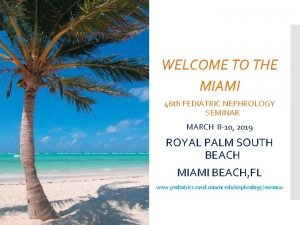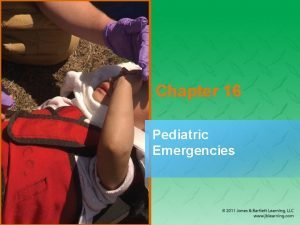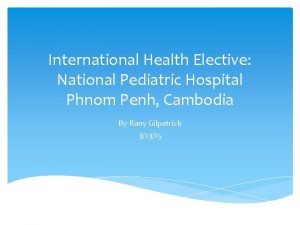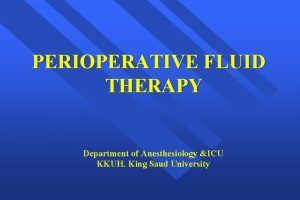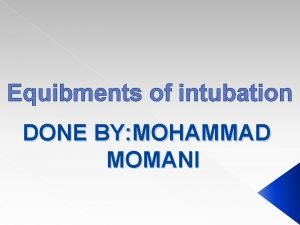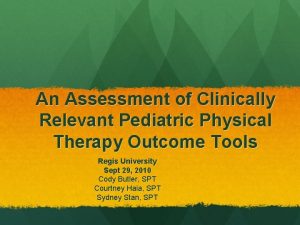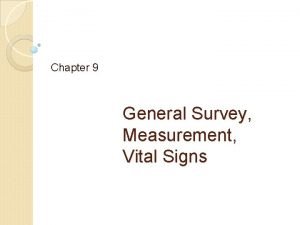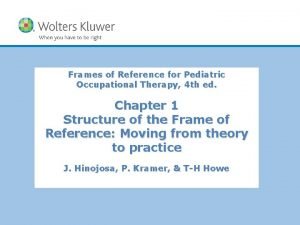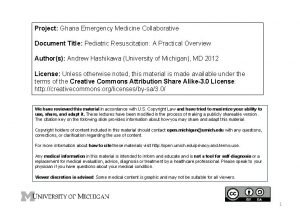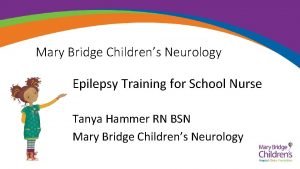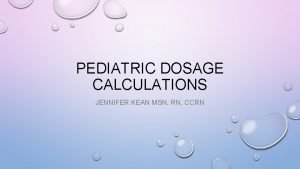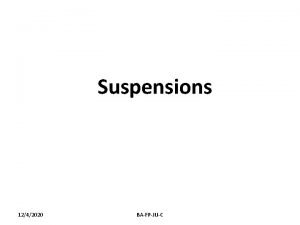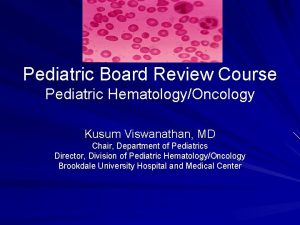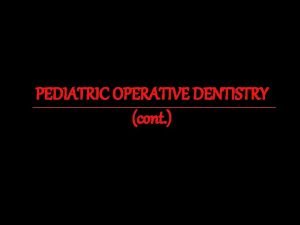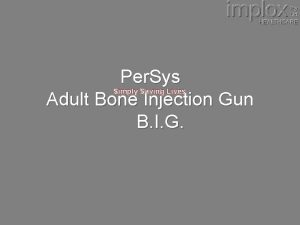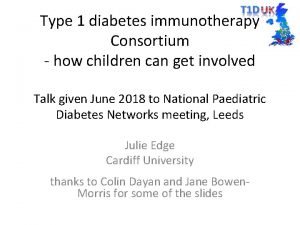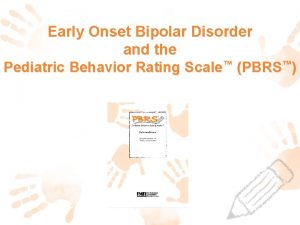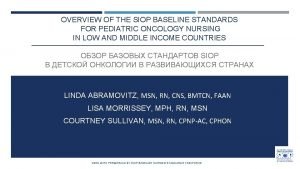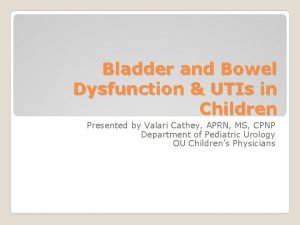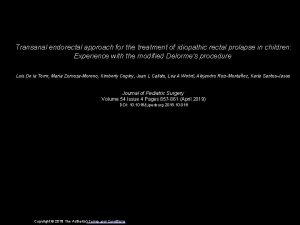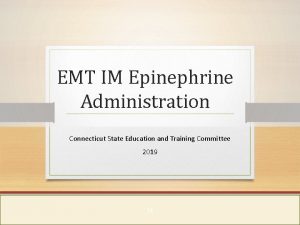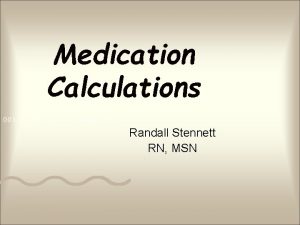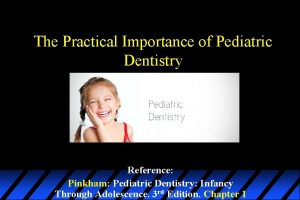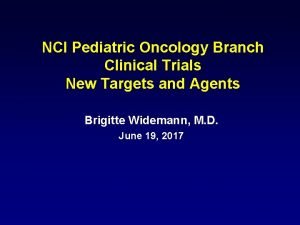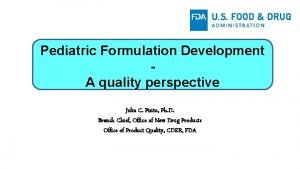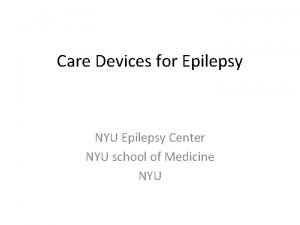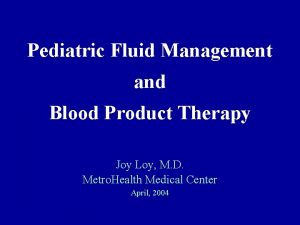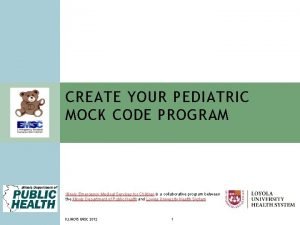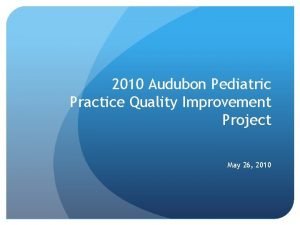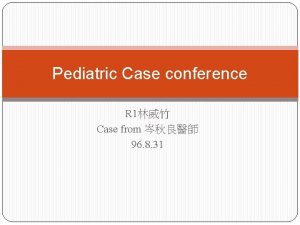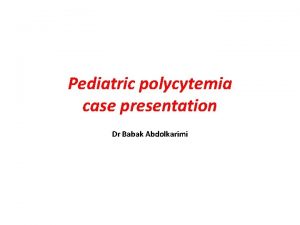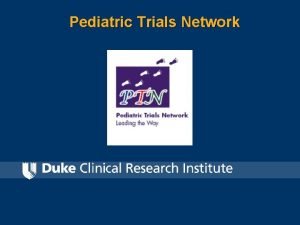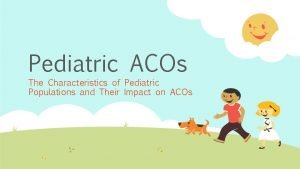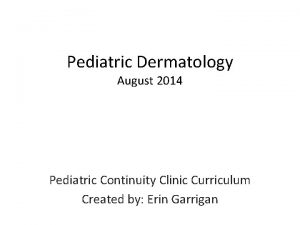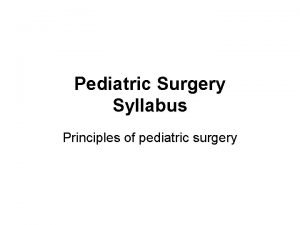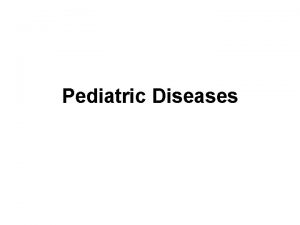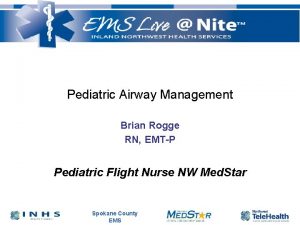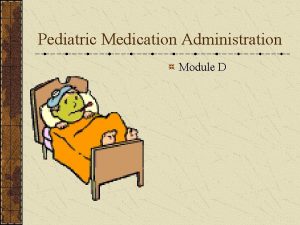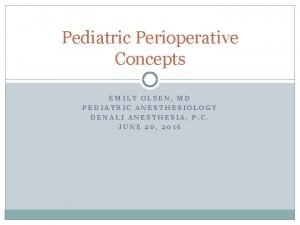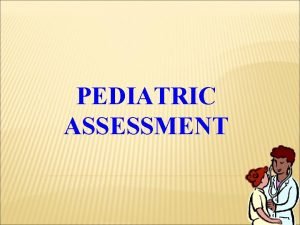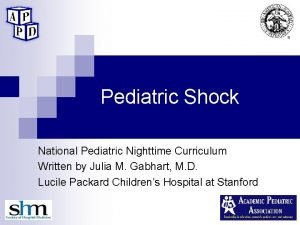Pediatric case Conference R 1 Pediatric case Conference















































- Slides: 47

Pediatric case Conference 報告人:R 1 李怡農

Pediatric case Conference 吳小弟 n 病歷號: 7169971 n 生日: 94/11/02 n 就診日期: 96/6/19 (1 y 7 m/o) n TPR: 36. 6/130/21 n CC:Fever for 2 days n

Present Illness Fever 38. 9 C for 2 days n Acetaminophen 4 ml q 4 h by family -> not subsided n cough(+) with sputum(+), rhinorrhea(+) n no diarrhea n vomit for 2 days, many times after drinking or eating n Activity: good n

Present Illness 過去病史: Ever admission due to Enterovirus and Pneumonia n 過敏史: denied n 旅遊史: denied n Vaccination: as schedule n

PE n n n n n PAT:Appearance/Breathing/circulation:all good Conscious: alert, Conjunctiva: not pale, injected(-) Throat: injected(+), Tonsils: enlarge(+), exudate(-) Eardrum: not injected Neck: supple, No LN enlarge Chest: Coarse BS, especial over right side Heart: Regular heart beat, No murmur Abdomen: Soft and flat; Normoactive bowel sound Tenderness(-), Rebound pain(-) Mc. Burney's point tender(-) Extremities: Freely movable, Skin rash(-)



Ped. 2 -D echo (2007/3/12) n n n n n Ao (mm): 15 LA (mm): 15 LVEDD (mm): 32 LVESD (mm): 18 EF: 78 % Dextroposition of heart. (Whole heart shift to right side of spine, apex pointed to left side) Normal intracardiac structural relationship. No pericardial effusion. Good ventricular performance. Vmax 0. 9 m/s for main pulmonary artery. No significant mitral and tricuspid regurgitation. No VSD, no PDA. 2. 9 mm atrial septal defect, secundum type. Normal left-sided aortic arch. Vmax 1. 0 m/s for ascending aorta Vmax 1. 3 m/s for descending aorta. Descending aorta at left anterior aspect of spine. Right-sided superior vena cava. Inferior vena cava at right anterior aspect of spine.

Hospital Course (6/25 -28) 3 D CT of chest performed on 6/25 n There is narrowing of the trachea in the level of aortic arch with narrowest diameter about 0. 25 cm about 1. 2 cm in length n There is dextrocardia with left side aortic arch n There is double SVC with left SVC drainage to coronary sinus n






Difficult Feeding / Dysphagia

Dysphagia any difficulty or abnormality of swallowing n may be life threatening if respiration or nutrition are compromised n Odynophagia (pain on swallowing) n sialorrhea (drooling) n

How to Approach Dysphagia n n n n Timing:Onset Age / Acute / Intermittent Nutrition:weight / develop Chewing / Solid / Liquid Pain / Fever Cough / dyspnea / stridor / Choking Drooling / Regurgitation / vomit Birth Hx / Pregnant Hx / Family Hx Trauma ?

How to Approach Dysphagia GI tract / Respiratory / Systemic n Pre-esophagus / Esophagus / Stomach / Intestine n Mechanical / Anatomy / Neurology / Inflammation / Miscellaneous n

Life-threatening Causes of Dysphagia n n n n Foreign-body aspiration/ingestion Tracheoesophageal fistula Upper airway obstruction Traumatic esophageal perforation Epiglottitis Retropharyngeal abscess Botulism n n n n Tetanus Polio Diphtheria Central nervous system infection/abscess Stevens-Johnson syndrome Corrosive ingestion Laryngeal paralysis


Vascular Ring


Vascular Ring n n n congenital condition anomalous configuration of the arch and/or associated vessels surrounds the trachea and esophagus forming a complete or incomplete ring around them usually occur without associated cardiovascular anomalies. Ventricular septal defect is the most common associated anomaly

Epidemiology less than 1% of all congenital cardiac defects n equal frequency in both sexes n Some vascular rings are associated with other congenital heart defects; others may be isolated deficits n

Etiology from the abnormal or incomplete regression of 1 of the 6 embryonic branchial arches n Several recent papers report the close association of band 22 q 11 deletion (20% of patients ) n

Arch Develop n Early in normal development, both a dorsal and a ventral aortic arch are present. The 2 arches are connected by 6 embryonic branchial arches



Subtype - 1 n n n Double aortic arch Complete Most

Subtype - 2 n n n Right aortic arch with left ligamentum arteriosum Complete These make up 8595% of the cases.

Subtype - 3 n n n Right aortic arch with mirror-image branching and retroesophageal ligamentum arteriosum Complete 小於 1%

Subtype - 4 n n n Left aortic arch with right descending aorta and right ligamentum arteriosum Complete 小於 1%

Subtype - 5 n n Retroesophageal right subclavian artery with left aortic arch and left ligamentum arteriosum not complete

Subtype - 6 n n Aberrant left pulmonary artery or pulmonary artery sling not complete

Clinical n n airway or esophageal compression. present with symptoms in infancy or very early in childhood stridor, cyanosis, wheezing, respiratory distress, apnea, and/or a characteristic high-pitched, brassy cough history of asthma, recurrent pneumonia, or evidence of dysphagia or difficulty with feedings

Clinical airway symptoms are worsened or aggravated by feedings n Others may try to maintain a position in which the head is hyperextended to improve breathing and minimize the obstruction n

Clinical n n n Dysphagia and symptoms related to the esophagus are the more likely presenting findings in older children and adults slow breast or bottle feeding, fatigue with feeding, frequent regurgitation, and aspiration pneumonias In most cases, workup is initiated when solid foods are introduced, which causes more pronounced dysphagia

Clinical The double aortic arch is the anomaly that usually produces the most severe airway compression in the youngest patients n some patients with a complete vascular ring have minimal symptoms or remain asymptomatic n

Diagnosis identification of a right aortic arch on chest radiograph n An ill-defined arch location is often observed in patients with double aortic arch n compression of the trachea and hyperinflation and/or atelectasis of some of the lobes of either lung n chest radiography is not very sensitive n

n n barium esophagram to be the most important study Double aortic arch produces bilateral and posterior compressions of the esophagus

Diagnosis n n n Echocardiographic studies have been increasingly used for the diagnosis of a vascular ring Structures without a lumen, such as a ligamentum arteriosum or an atretic arch, have no blood flow and are difficult to identify identification of compressed midline structures and their relationship to encircling vascular anomalies may be difficult to detect

Diagnosis CT/MRI/Angio:These expensive radiological studies are rarely necessary to evaluate vascular rings n Although these modalities provide excellent delineation of all of the associated structures, they should be reserved for cases in which the results of barium esophagram do not provide a clear diagnosis n

Diagnosis Bronchoscopy has been used in the evaluation of children with symptoms of airway obstruction or compression n In the presence of a vascular ring, pulsatile external tracheal compression is easily observed n

Treatment No medical therapy exists n Surgical division of symptomatic vascular rings is the only appropriate form of therapy n surgery should not be delayed in the presence of a respiratory tract infection n

Prognosis About 95% of patients who undergo surgical correction of a vascular ring survive long term n most of these are soon relieved of their symptoms n

Discussion Time

Thank You For Attention
 Best worst and average case
Best worst and average case Glennan building cwru
Glennan building cwru Bubble sort best case and worst case
Bubble sort best case and worst case Bubble sort algorithm pseudocode
Bubble sort algorithm pseudocode Ambiguous triangle
Ambiguous triangle Long case and short case
Long case and short case Crm failure case study
Crm failure case study Binary search big o
Binary search big o Bubble sort best case and worst case
Bubble sort best case and worst case Pediatric assessment triangle ticls
Pediatric assessment triangle ticls Drug dose calculation
Drug dose calculation Pediatric life support algorithm
Pediatric life support algorithm Miami pediatric nephrology seminar
Miami pediatric nephrology seminar Pediatric triangle
Pediatric triangle When administering ear drops to adults the pinna is pulled
When administering ear drops to adults the pinna is pulled National pediatric hospital phnom penh
National pediatric hospital phnom penh Mount washington pediatric hospital
Mount washington pediatric hospital Plasmlyte
Plasmlyte Pediatric equipment list
Pediatric equipment list Pediatric physical therapy outcome measures
Pediatric physical therapy outcome measures Pediatric nursing definition
Pediatric nursing definition Resuscitate
Resuscitate Amoxicillin peds dosing chart
Amoxicillin peds dosing chart Normal vital signs for all age groups
Normal vital signs for all age groups Pediatric occupational therapy frames of reference
Pediatric occupational therapy frames of reference Wikimedia
Wikimedia Mary bridge neurology clinic
Mary bridge neurology clinic Jennifer kean
Jennifer kean Preparation of suspension
Preparation of suspension Hematology oncology board review course
Hematology oncology board review course Vague questions examples
Vague questions examples What is isthmus in cavity preparation
What is isthmus in cavity preparation Pediatric big bone injection gun
Pediatric big bone injection gun Pediatric diabetes consortium
Pediatric diabetes consortium Pediatric behavior rating scale
Pediatric behavior rating scale Pediatric rn
Pediatric rn Voiding cystourethrogram
Voiding cystourethrogram Triage start
Triage start Pediatric surgery
Pediatric surgery Pediatric epinephrine dose chart
Pediatric epinephrine dose chart Dose on hand formula
Dose on hand formula Pediatric dentistry definition
Pediatric dentistry definition Nf1pn
Nf1pn Pediatric formulation development
Pediatric formulation development Nyu epilepsy faculty
Nyu epilepsy faculty Pediatric fluids 4 2 1
Pediatric fluids 4 2 1 Mock code steps
Mock code steps 21 audubon pediatric clinic
21 audubon pediatric clinic










